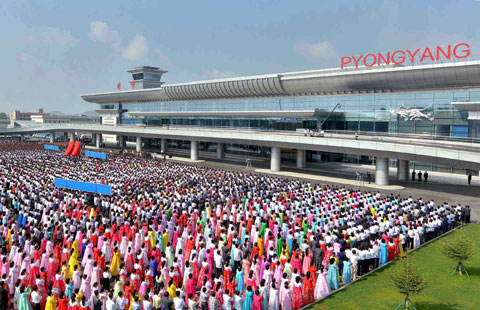
First, it is important to uphold the environment for peaceful development. Peace is the number one guarantee for development, without which nothing could be accomplished. This year marks the 70th anniversary of the founding of the United Nations and the victory of the world’s anti-Fascist war. Overall peace in the past 70 years has brought unprecedented development and prosperity. The outcome of the hard-won victory needs to be cherished. The purposes and principles of the UN Charter should be safeguarded, and the UN-centered post-war international order should be resolutely upheld. Deep economic globalization has bound the interests and destinies of countries closely together. But the world is by no means peaceful, and hotspot issues and local conflicts have kept cropping up. China believes that relevant parties need to find a peaceful solution through cooperation, dialogue and negotiation. The international community should respect the will of relevant countries and peoples and endeavor to foster an atmosphere for unity and reconciliation. The Chinese culture has all along valued peace and virtue and rejected the practice of bullying others or imposing one's own will on others. China was, is and will continue to be a strong advocate and facilitator of world peace and international order. China will be resolute in upholding its territorial sovereignty and core interests. China calls for the establishment of a regional cooperation mechanism to ensure that we continue to enjoy an environment of world peace and regional stability.
Second, it is important to step up structural reform. History shows that crises, more often than not, are accompanied with opportunities for change. Countries concerned have learned useful lessons from the international financial crisis. They have realized that vigorous structural reform is the surest way to getting out of the global economic downturn. On top of that, rapid spread of new technologies, like the Internet, big data and 3D printing, also adds new impetus to world economic recovery.
In my view, structural reform, first and foremost, is about stimulating people's initiative and creativity and sustaining economic growth. Indeed, everyone has a gift for imagination and creation. The Chinese say that when people are of the same mind, they could move Mount Tai. And Westerners say that two heads work better than one. Just imagine if the talent of all seven billion people on earth could be leveraged. The result would simply be miracle. It is imperative that we follow the trend of the times and have structural reforms to remove institutional and structural barriers to people's ingenuity. This could accomplish more than invigorating the market. It will also facilitate fairer distribution and inclusive growth.
In recent years, the Chinese government has strongly encouraged mass entrepreneurship and innovation. This is aimed at leveraging the wisdom of the 1.3 billion Chinese people, particularly the 900 million in the workforce, and fully tapping the potential of the over 70 million market players, especially the over 19 million enterprises. We know that big things can only be done by pooling the wisdom of people together, and I myself have seen success stories with my eyes. In May this year, I visited the 3W Cafe in Beijing's Zhongguancun area, where aspiring young men and women have been given the opportunity to turn their good ideas into good business and realize their dream of setting up their own businesses. In fact, big companies in China are doing just the same. The Haier Group, for instance, has shifted their traditional hierarchical management system and set up a new platform for entrepreneurship and innovation. Their employees have become makers who produce all kinds of fancy ideas on the platform. These ideas are later on developed by Haier itself, or in collaboration with other companies. This way, the platform for new ideas has incubated over 2,000 small and micro businesses and nurtured over 1,000 innovative products and startup projects. Over 1,300 venture investment funds have been attracted, and more than one million jobs created. The China National Nuclear Corporation, for another example, has developed the Hualong One nuclear technology through Internet-based R&D in collaboration with over 20 research institutes on 500 terminals. So we have seen what could be done when huge potential is unleashed for entrepreneurship and innovation.
To encourage mass entrepreneurship and innovation, the Chinese government has taken measures to streamline administration, delegate power, strengthen regulation and improve services. New market players are increasing in exponential terms. Each day in the past five months, some 10,000 new businesses were registered. Most of them are small and medium-sized enterprises (SMEs) or service providers. Together, they employ lots of people. As a result, more jobs have been created and employment for the young has grown steadily despite a moderated speed of economic growth. All this is attributable to reform and innovation. Entrepreneurship and innovation know no boundaries. China wants to increase interaction and cooperation with other countries to jointly address technological challenges, remove barriers to technology transfer and open up new sources for economic growth.
Third, it is important to carry out global cooperation on production capacity. Since the outbreak of the international financial crisis, some countries have taken a QE policy, which was necessary to forestall an economic recession. But to ensure strong growth of the world economy, it is imperative to adopt multiple measures to support the real economy. One way to do that is to carry out global cooperation on production capacity. Now nearly six billion people live in developing countries. Many of them are at the early stage of industrialization. This means a huge need for poverty reduction, infrastructure development and equipment manufacturing, which all serve to spur growth. Yet limited financial resources may have barred many of these countries from getting high-end equipment. China, for its part, has entered the middle stage of industrialization. The sheer size of China makes it the largest producer of more than 200 industrial products in the world. Chinese equipment, being at the middle-end of the global industrial chain, is competitive given their high quality and low prices. And when it comes to developed countries, they are in the advanced stage of industrialization or even a post-industrial period with a focus on re-industrialization. So they have an advantage to offer in terms of high-end equipment and technology. China’s strength in equipment manufacturing could well be tapped to meet the need of developing countries for lower procurement costs and industrial upgrading. China may also work with developed countries to set up joint ventures or cooperative operations. China may buy core technologies, key parts and components and energy saving and environmentally friendly equipment from developed countries, therefore offering developing countries inexpensive, quality and energy conserving products that are more environmentally friendly. During my recent visit to Latin America, I got on-board a China-made ferry that is powered by a diesel electric system purchased from a developed country, instead of a conventional diesel engine, making it largely pollution-free.
China calls for open global cooperation on production capacity. The idea involves advanced technology and equipment from developed countries, localized production and assembly in developing countries as well as financing cooperation with international financial institutions. Such a cooperation model will provide the global market with cost effective equipment, production capacity and solid financial services. During my current visit, China and France signed an agreement on jointly exploring third-party markets. China's production capacity will be joined with advanced technology of France and other developed countries to promote infrastructure development, industrialization and poverty reduction in developing countries. This will raise the level of industrialization in developing countries, promote China’s industrial upgrading and drive the export of core technologies and creative products from developed countries. The result could be win-win for all three parties. I believe this could be a new and important way for South-South and North-South cooperation. It could boost the real economy and help counter the downward pressure in global economy. In fact, both industrialization in developing countries and re-industrialization in developed countries will be advanced if we could properly combine financing cooperation with development of the real economy, and capital support with trade in investment goods.
Later this year, the United Nations will convene a development summit, a climate change conference and the Third International Conference on Financing for Development. We call on developed countries to follow through on their ODA commitment, scale up support to developing countries, especially least developed countries in Africa and elsewhere, and further cut the debts of and open up markets to developing countries. China stands ready to work with all parties to deliver a fair, inclusive and sustainable post-2015 development agenda. On climate change, China has outlined its nationally determined actions and policies before 2030, and will work with other countries towards reaching the much-anticipated new climate deal at the Paris conference.
Ladies and Gentlemen,
I know many of you are interested in China’s economic prospect. Let me assure you that on the whole, the Chinese economy is steady and moving in the right direction. GDP grew by 7% in the first quarter. Major economic data of May and June such as industrial output, investment, consumption and export have stabilized and rallied, and market confidence has strengthened. Economic structural adjustment has picked up speed — the services sector now accounts for more than half of the economy, and new products, sectors and business models have emerged in great numbers. In the first five months of this year, online retail sales rose by 38.5%. In May, output of new-energy cars and industrial robots increased by 2.8 times and 1.3 times respectively. All these point to the fact that China’s industrial development is upgrading and the Chinese economy is being driven by new growth drivers.
There is no denying however that China still faces downward pressure and some deep-seated problems. But these are “growing pains”. We will strike a proper balance between steady growth and structural adjustment, continue to implement the proactive fiscal policy and prudent monetary policy, and strengthen targeted regulation on the basis of range-based regulation so as to cushion the downward pressure through deeper reform and opening-up. Our aim is to keep the economic momentum with moderated rate of growth and to raise both the quantity and quality of the Chinese economy. Given the size of the Chinese market, there is a variety of regulation tools we may resort to. We have both the confidence and the capabilities to meet the target set for this year, and we will strive to sustain medium-high rate of growth and move the Chinese economy toward medium-high level of development.
Ladies and Gentlemen,
China as a developing country has engaged the OECD in various forms of exchanges and cooperation since our policy dialogue started 20 years ago. While China has benefited a lot from the OECD’s views and recommendations, China’s development has offered the OECD a broader perspective in its research endeavor. Before coming here, Secretary-General Gurria and I discussed ways to deepen the OECD’s cooperation with China. The two sides also signed a Medium-term Vision Statement and a joint Program of Work for 2015-2016, identifying priority areas and the roadmap for future cooperation. Here I wish to announce the formal accession of a Chinese institution to the OECD Development Center. As China will play host to the G20 summit next year, we look forward to discussing with all parties ways to advance development, and the OECD’s strong support is more than welcome in this connection.
The Chinese culture emphasizes the need to match knowledge with action. Let us think and act together to come up with better ideas and more concrete actions to advance the common development and wellbeing of the entire human race.
Thank you very much.








